The best distortion pedal is designed to distort the sound produced by electric guitar and bring new multi-level harmonics into the sound pattern. It imitates the sound of the amplifier being overloaded. The origins of such devices may be traced back to the 1960s and rock music, while sound distorters subsequently became inseparable components of grunge and heavy metal songs.
The distortion tools aren’t alike. They feature their own “character” and way of affecting the sound. Going through the market offers, consider the main criteria:
- Type. As usual with sound equipment, the analog models provide more variations and cleaner and more natural sound. On the other hand, digital pedals bring more stability of effect and allow programming it precisely to the player’s liking.
- Sound effect. There are three types of sound changer pedals, depending on the generated sound, the amount of distortion, and the replication of the original sound. Overdrive pedals slightly deviate from the main sound pattern, bringing several harmonics into it. Distortion pedals bring more grit and modify the sound much more, sometimes to unrecognizable effect. Fuzz pedals change the sound the most transforming it in a completely different signal, with a lot of power and side effects.
- Controls. Regular models feature simple tone and gain regulators, while some let change the frequency range, the sonic proportion of the signal and control its volume.
Still unsure as to what pedal you need? Come and try one after reading about the most popular distortion boxes, and compare the sound!
Distortion Pedal Reviews
BOSS DS-1
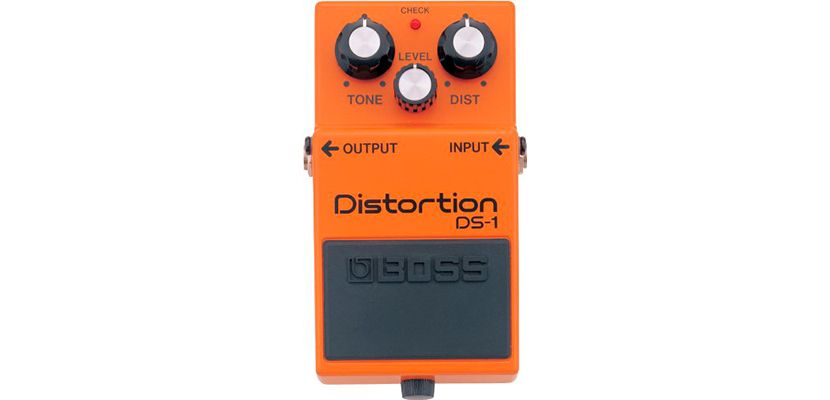
The Boss DS-1 distortion pedal is a market leader due to its powerful performance and clean original sound from overdrive to distortion. Still, its bright high-pitched treble might not fit the liking of bass-oriented players.
The dist box can be tweaked in different ways while keeping the output clean and full of power. It works well throughout the standard frequency range and provides various distortion effects from classic rock-style alike to AC/DC riffs. Gain wound up, it can emit more hairy sound merging on harshness but still clean and precise.
This gadget has three knobs for regulating the sound and adjusting the distortion effect in a variety of ways. The Tone dial lets choose the right frequency and balance the output. The level determines the amount of power to be added to the sound, while the Distortion knob controls the modification level. The latter can be a warm overdrive or a crunching riffs, or a sloppy viscous low-end sound.
Overall, the Boss distortion pedal enriches the sound with multiple well-outlined harmonics letting preserve the audio played and add instant jolt and crunch drive into the music played.
Pros
- Very sensitive tonal control allows tweaking the sound in fractions.
- A large footpad area doesn’t let miss the pedal in a rave.
- Sturdy while lightweight casing and rubber foot make it sit still during the performance.
Cons
- With high tone and gain, it might sound tinny and hollow.
- A bit noisy in the idle mode.
Video BOSS DS-1
Pro Co RAT2
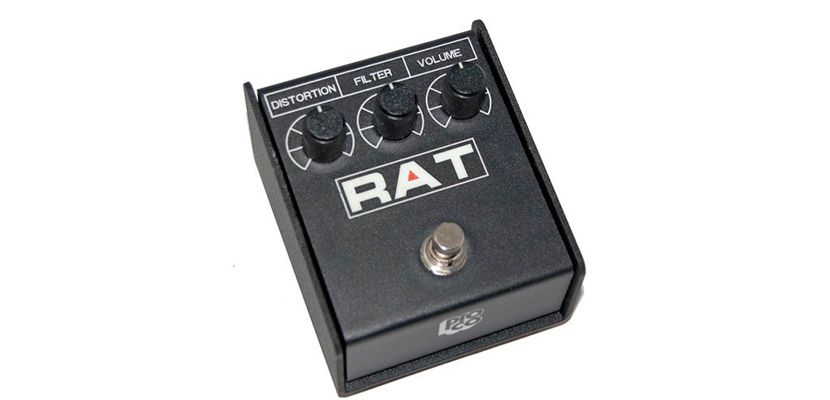
Plenty of power, no drop-off of low and high end, signature rhythm make this pedal opt for the best distortion pedal for grunge and other “garage” styles. It’s still too muddy for lighter genres needing smooth overdrive.
The stompbox feeds high dynamics combining vibrant treble with some heavy bass grinding. While the output merges on the fuzz effect and provides a lot of distortion, there are no frizzy clips or overly fat and muddy lows. The riffs appear solid and chuggy, with a great attack. Though the original sound might turn to be unrecognizable upon Distortion level being wound up, the audio stays tight and concentrated, with the harmonics clearly traced.
The three dial settings adjust the gain, tone, and measure of sound modification. They are quite sensitive and easy-to-use, bringing up countless variations of the distort effect. The Filter (tone) serves for refining the highs, making them sound less bright and pitchy and darkening the overall sound. The Distortion knob regulates the amount of crunchy attack introduced and brings a lot of fatness to the bass end.
Originating from one of the first-of-a-kind classic pedals, this Rat distortion pedal emits a well-known sound used in many classic rock compositions. It has a solid build securing the audio from unwanted resonance and shrill.
Pros
- Bypass switch lets route the signal directly when the pedal isn’t used.
- Sounds like the tube amp, no digital aftertaste present.
- The LED light indicates whether the pedal is on or off.
Cons
- Sounds too muddy on extended range guitars.
- Bulky and heavy, takes space.
Video Pro Co RAT2
Electro-Harmonix Soul Food
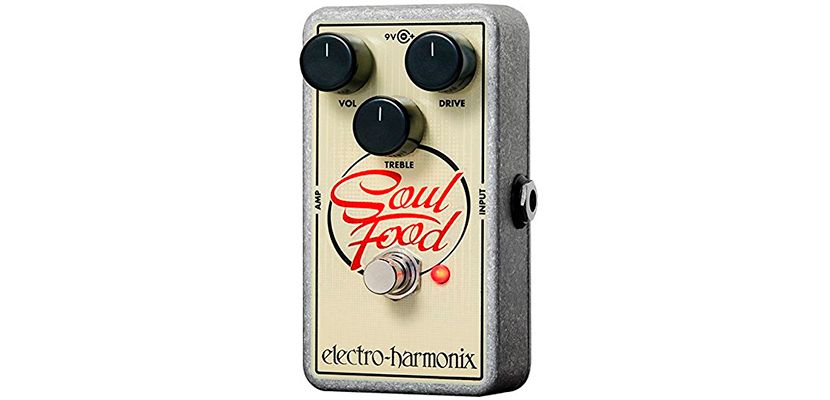
High versatility in sound effect and usage and tailor-cut sensitivity make this device a solid option among the best distortion pedals that we’ve picked. Still, it lacks a crushing attack and grit of the “heavier” stompboxes; so, a grunge and hardcore lovers mightn’t get what they look for.
With the smooth and clear precisely leveled distortion, this pedal serves well for the overdrive effect. The overall tone is a retro-sounding tube, smooth and gentle. Still, it’s also capable of cranking up a harder drive and crunch, with well-traced metal leads. The device boosts the signal in full, bringing the mids in focus, and determining a solid main tone. The enhanced power rails enable the vast range of headroom tones and let the output be extremely clear.
This guitar distortion pedal offers a variety of features and options. Its highly sensitive controls let tweak each tiny fraction for the sound frequency and distort level bringing the needed effect. By darkening the overall tone, the Treble knob allows you to brighten the highs or nearly drop them. It also provides two bypass options: direct and buffered one, for various sound gear combinations.
Pros
- Instant signal processing and response.
- Transparent gain boost, with well-traceable sound changing effect.
- Very clean output, capable of boosting the sound with zero coloration.
Cons
- Somewhat thin at low gain setting.
- Popping when turning the pedal on and off.
Video Electro-Harmonix Soul Food
TC Electronic Dark Matter
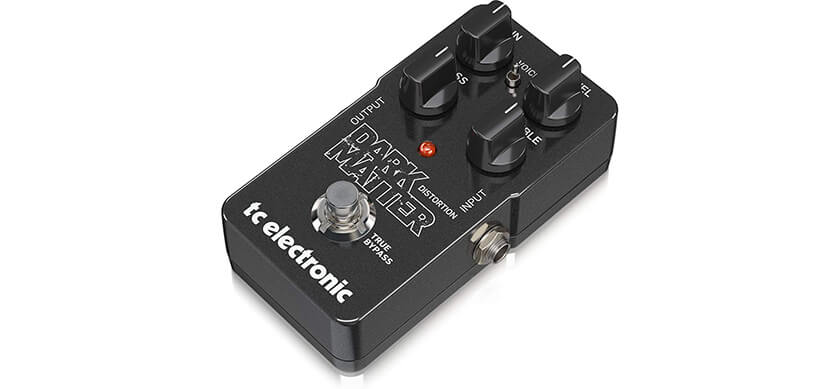
Diversified EQ-tuning, vast dynamics, and all-analog build make this distortion pedal a great option for both beginner and pro-level guitar player. Still, on high gain levels, it might sound a bit sticky.
The analog circuitry incorporated in this dirt box provides for a vast range of effects and full, rich sound. It plays the overdrive smoothly and on verge of break-up while preserving the initial signal clear. The pedal is made out of top-quality components emitting the neutral, exact and powerful sound, fitting well blues and classic rock rolls, with high dynamics preserved throughout the performance.
Separate settings for treble and bass are applied to the stompbox, revealing millions of distortion possibilities. The knobs are sensitive and intuitive to use providing an immediate response to every movement. The pedal integrates the fully isolated bypass, admitting no hum or color to the sound passed through, while the device isn’t engaged.
The Dark Matter pedal fits well as an overdrive box; however, tuned rightly, it’s capable of giving out a pinchy attack of a vintage-like distortion. It doesn’t compress the audio passed through while featuring a familiar valve-like Plexi sound.
Pros
- Voice switch changes the overall tonality bringing the further high or low end of midrange.
- With the proper setting, gleaming metal tones may be amplified.
- Retains musical character throughout the extreme distortion levels.
Cons
- Too lightweight and not too sturdy.
- Produces hiss when wired with single-coil gear.
Video TC Electronic Dark Matter
Wampler cataPulp V2
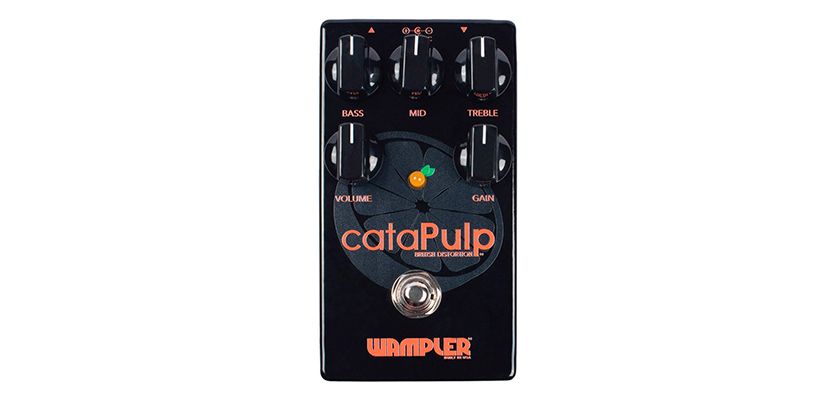
This aggressive powerful pedal uncovers bursts of attack and dynamics and features a solid low end, for which it’s also can be praised as a bass distortion pedal. Still, the battery-less design and large size do not make it a portable option.
Imitating the Orange 50-Watt amp and the characteristic British grit sound, this pedal is capable of delivering a broad assortment of effects. It brings a full-body, deep sound with well-drawn tones and features high dynamics with a lot of punch and grind. Wound up, it can clip sharply, piling up the harmonics and letting the sound hover on the edge of real fuzz. It doesn’t make a syrupy effect, though, outlining the tone precisely.
With active equalization for all three tones, the device lets mix freely injecting just the right amount of bass, midrange, and treble into the sound. It doesn’t just modify the frequencies coming along the input signal but boosts or cuts them accordingly with 15 dB max.
The Level knob on this distortion pedal is dependent on the Gain amount, while the optimal balance is usually easy to achieve. This device is very versatile and can be used to play a wide range of styles, from classic ’70s rock to hardcore.
Pros
- Can be used as a gain stage, due to clean signal output.
- No-contact bypass provides for zero interference with the signal when idling.
- Supports clear and concentrated treble even on high distortion levels.
Cons
- Winding up the gain adds noise significantly.
- Costly, the price is 4 times higher than that of most competitors.
Video Wampler cataPulp V2
MXR M75 Super Badass
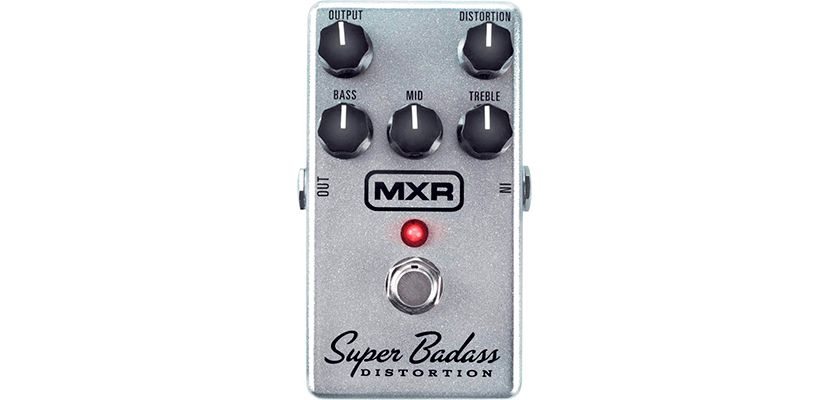
Entirely analog design, versatile equalization, wide distortion range of this MXR distortion box will satisfy the lovers of early metal rock and modern heavy styles. Still, its somewhat limited tone control wouldn’t let it mix over-the-edge high-pitched effects.
This dirt box crunches solidly while keeping the mids clear and well-traceable. It can boost the primary signal or layer up numerous harmonics, for a classic 70s rock riffage. When you increase the distortion level, it provides a thick murmur and a variety of metallic groove effects.
The pedal has separate tweaking knobs for bass, mids, and treble letting find an optimal balance. The sound can be dry or viscous, with more or less muddiness, depending on the player’s liking. The distort box features a wide output range providing for both spacious vibrant effects and the mid-scooped ones.
The MXR Super Badass Distortion pedal utilizes a complete bypass circuitry making the signal flow by unaffected when the stompbox is out of use. With all the diverse controls and integrated circuitry tricks, the pedal is quite compact and can fit any pedal board with ease.
Pros
- Balanced output lets get the molten leads on high distort levels without too much muddiness.
- Sensitive controls allow you to mix all styles.
- The durable build of the casing, knobs, and ports.
Cons
- Volume is overly loud at a standard / unity level.
- Produces a white noise at high distortion levels.
Video MXR M75 Super Badass
Fender MTG Tube
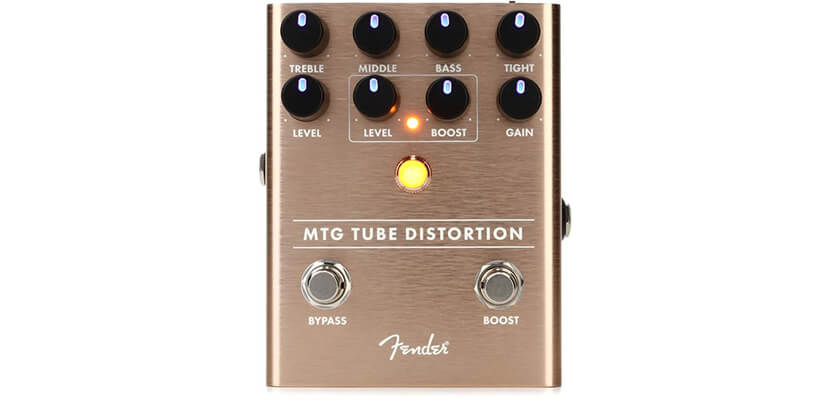
Highly diversified controls and equalization, solid design, and original rock sound of a tube amp make this distortion pedal a worthy acquisition for any follower of the classic rock music. Still, for the same price level, the competitor models provide a fraction cleaner and richer sound specific for boutique models.
This exquisite distortion box has a real tube in its construction powered through the standard 9V port (further transformed internally into 150V of sheer power). The sound coming out of this pedal features the main benefits of a real (though tiny) tube: natural character, concentration, and purity. It provides a rounded, accurate distortion boosted with the high dynamic output, and delivers a vast field for sound experiment.
The stampbox features two rows of controls, including a full set of EQs. The lower row features a separate frame for boost tweaking. While having a fully transparent tone, the boost can be tuned both for the amount of power and distortion, getting the audio from a full-overdriven tube effect to the gentle soul-rock strings.
The controls on this tube distortion pedal are highly sensitive and easy-to-use. They are made solid and respond to the slight touch. The casing is made of anodized aluminum providing a good weight and recognizable brand design.
Pros
- “Tight” control brings a focused rich and saturated bass distortion at a high gain setting.
- Boost switch is foot-activated.
- LED backlight for controls is helpful and can be switched off.
Cons
- The tube is difficult to replace once it wears out.
- A power cable is not supplied.
Video Fender MTG Tub
Electro-Harmonix Metal Muff
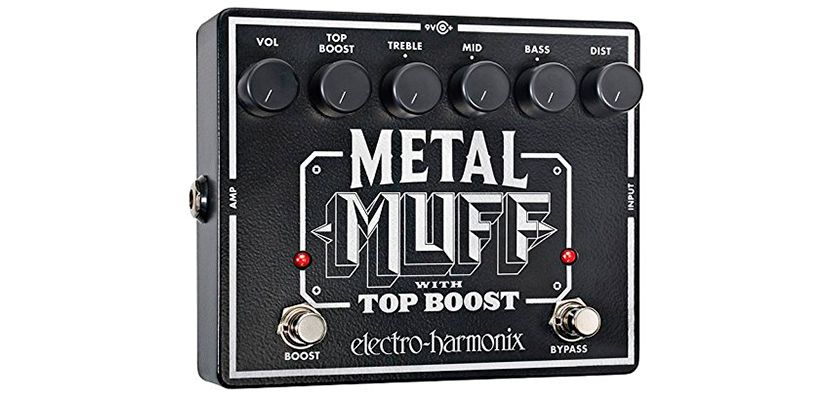
Thanks to its precise response and precise controls, this distortion box is capable of producing rock-metal sound at explosive volumes. Its sheer dynamics and highly concentrated attack let it claim the title of the best distortion pedal for metal. Still, the large size might cause trouble squeezing this unit onto a standard pedal board or carry it along to the gig.
The pedal sounds composed at both default and extreme gain settings. With the gain increase, the sound drops the smoothness completely and becomes sharp and clipping. Still, the well-balanced structure is easily traced. Mids are solid but can be completely scooped depending on the EQ tweaking. Bass gets compressed without losing the attack, and highs become darker and edgy. The sound acquires a girth while the rhythm stays precise.
The controls are simple featuring the three-band equalization, the Volume and Distortion knobs. However, the ace in the sleeve is Top Boost dial driving the sound off the track and whops up the air in a powerful fizzy attack. Overall, the Metal Muff serves as a very versatile pedal, suitable for both clean gain and hard crunchy and dirty metal distortion.
Pros
- Buffered bypass tech works seamlessly keeping the signal clean.
- Wide range for EQ tuning.
- Battery and DC power connectivity options.
Cons
- Stiff buttons need a few pressures to become more responsive.
- The battery drains fast.
Video Electro-Harmonix Metal Muff
Buyer’s Guide
Selecting a Distortion Box
The dirt boxes differ by type, circuitry, controls, and many other factors. Before you cutting the check for a new pedal, take a quick walk through the basic ones:
- Build. The solidity of the box itself and the controls, input and output connections, easy opening of the battery compartment, casing and feet material tell a lot about pedal’s quality. Besides, sturdy build ensures no unwanted side effect to the sound.
- Tone. Each pedal has its own tone. However, the actual performance would vary depending on the actual setup. The stompbox might sound worse or better than at store’s and affect other components of the line (e.g. a wah pedal, preamp, etc.)
- Versatility. Modern stompboxes mostly deliver a wide range of effects. Still, the amount of tweaked parameters differs greatly.
- Price. The distortion gear is all about personal liking; thus, the price tag isn’t too informative for this sound equipment.
Versatile vs. Usable Dirt Boxes
Most of the modern guitar dist pedals feature numerous options for sound tweaking. However, “versatile” and “usable” models differ by the range of control the player can get over the output.
Versatile units feature highly sensitive controls, diversified EQ options and might feature other regulators for gain. They require a thorough setting while letting the player control each tiny bit of change within the sound. These stompboxes usually encompass a vast variety of effects and can provide the classic overdrive, distortion, and fuzz with a good amount of attack and sound clarity.
Usable models provide fewer possibilities for fine tuning while the default sound modes emit the signature sound already set at the optimal performance of the pedal. These boxes can be played right out of the box, while the tweaking opportunities are limited in comparison to versatile models. They usually stick to some determined function like a fuzz pedal, for instance.
Digital or Analog
The distortion gear can have digital or analog construction. Analog models have a simple structure, and their output corresponds to the way the human ear perceives sound waves. The audio produced by analog equipment is usually regarded as “warm” and “natural” non-depending on the actual sound that might be full of accumulated harmonics and feature muddy and thick low end.
The digital audio devices have the complex decoders introduced into their signal processing chain. The sound is coded into zero-one digits, processed and decoded back into the analog output. While such technology presumes more components involved and inevitable losses in terms of signal saturation, the high-quality digital pedals can make these shortcomings almost non-traceable. Meanwhile, a coded sound is easily reproduced each time the pedal is activated. So, choosing between digital and analog pedal is a matter of quality and personal preference rather than sound saturation.
Bypass Type
Guitar pedals aren’t made to be active full-time. Instead, they’re turned on for a fraction of time to introduce a particular effect to the performance. Still, the box is wired in with other gear in the chain, even when not working. The way the signal is coming through at idling periods is called “bypass type”.
There are three ways to bypass the stompbox:
- True bypass. The signal comes through the pedal not entering its inner circuitry. This kind of bypass aims to preserve the signal in its clarity and power. However, when passing through a stack of equipment, the signal might lose the power and drop the high-end frequencies.
- Hard-wired bypass. The signal passes through the pedal’s circuitry. This makes it lose a high end frequently, and even acquire some noticeable distortion.
- Buffered bypass. The signal goes through the pedal and is amplified by its circuitry. While in some cases this might cause the sound coloration and / or interference, in the high-quality boxes, such bypass scheme helps preserve the signal and delivering it without loss through the chain of sound equipment.

Hi everyone! I’m Thomas Moody, also known as Guitarzan.
